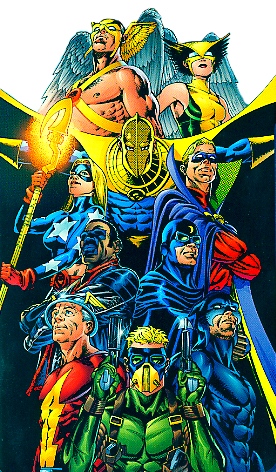JUSTICE SOCIETY OF AMERICA
Post-Crisis Chronology:
Introduction
Assumptions
This chronology is edited assuming:
- Events occurred in the unified timeline of "New Earth." This is the continuity following the Crisis on Infinite Earths, when all parallel Earths were merged into a single universe.
- Events largely involving Earth-Two characters such as Superman, Batman, Wonder Woman, Robin, and the Huntress are not included. The exception is the Earth-Two Superman's participation in Infinite Crisis. To read Earth-Two continuity in its original form, please read the Earth-Two Chronology
About the Different Realities Referred to Herein
-
 Pre-Crisis
Reality (The original "Earth-Two" era)
Pre-Crisis
Reality (The original "Earth-Two" era)
(April 1958-January 1986):
The original version of the DC Universe, which included an infinite number of parallel Earths. The two most notably: Earth-Two, which was populated by DC's Golden Age heroes; and Earth-One, inhabited by heroes from the Silver Age onward. - Post-Crisis Reality ("New Earth")
(January 1986-2006):
After the Crisis on Infinite Earths, all infinite Earths were merged into a single "New Earth." This new reality, which will be referred to as the "post-Crisis reality," contained no parallel Earths. For the JSA, this meant that members with strict Earth-One counterparts (Superman, Wonder Woman, Batman, Robin and Huntress) were erased from the timeline. A history without them coalesced.
It was later discovered that the JSA's Wonder Woman, Superman and Power Girl (of Earth-Two) survived the collapse of the multiverse. Wonder Woman and her husband Steve Trevor went to live on Olympus. Superman in a crystalline "haven" created by Alexander Luthor. Power Girl was shunted onto New Earth with no clear history. - Hypertime (established 1999):
For a time, any alternate timeline was explained as part of Hypertime. Like the infinite Earths before, Hypertime was an infinite branching of the DCU timestream. "Tributary" timelines were said to diverge from the "main" timeline. And, sometimes those tributaries feed again back into the "main" timeline. Created by Mark Waid during the 1999 Kingdom event, Hypertime seemed an obvious attempt to explain rampant poor continuity. Also, DC house ads began using the phrase "The Original Universe" when promoting an in-continuity book (set in the "main" timeline). All others are referred to as "Elseworlds" (set in "tributary" timelines).
For example, following the Crisis, Power Girl was explicitly removed from any membership in the JSA. Here the timeline diverged and an Elseworlds tributary traveled on in which she was a JSA member; the main timeline continued without her as a member. Gradually, more and more stories were told placing her firmly back into JSA membership (cemented in JSA: Our Worlds at War). Why, this can only be because that erstwhile tributary was "feeding back" into the main timeline. So anything goes. Continuity is ever-changing. - Post-Infinite Crisis Reality (2006-present):
Even before Alexander Luthor used his powers to recreate the multiverse, his henchman, Superboy Prime had been pummeling against the crystaline barrier of their "haven" outside normal time/space. Each blow reordered New Earth's history. Once free, Luthor birthed infinite Earths once again. Upon his defeat, they were merged back into a single Earth, but the leftover energy from his multiverse was channeled into the creation of 52 identical Earths.
The 52 Earths were then corrupted by Mister Mind, who "ate" events from all 52 Earths, altering their history and making each one unique. Now, again, there is an Earth-2 on which the Justice Society is the predominant force for good. This Earth is totally different from the original, pre-Crisis Earth-2, but shares some similarities.
Standards
- Color Codes:
Major story arcs (usually 3 issues or more). A new member joins the JSA. A hero dies Events with continuity anomalies - Preference is given to the most recently published DC Comics story (like Wonder Woman/Hippolyta's joining the JSA). Exceptions are taken, however, where the most recent story is outweighed by a mountain of other evidence.
- Characters' first appearance IN PRINT is bolded. These instances refer to the first appearance a character in post-Crisis continuity. (For example, Brain Wave: 1st chronological app. in All-Star Squadron #19, and 1st app. In print is All-Star Comics #15.)
- When the placement of a tale within continuity is in question, the tale is usually placed in the most recent possible time.
- The "XX Years ago" information is adapted from the information given in DC's Secret Files comics. Secret Files timelines are highly contradictory.
- Only the inheritors to a title display the level of succession. Example: "Green Lantern II" (for Hal Jordan), but just "Green Lantern" (no "I" for Alan Scott).
- Consideration for inclusion is based on an event's relevancy to the JSA, its members, and their legacy. This includes major JSA series and key issues from other DCU series.
- Major series included in this chronology:
- All-Star Comics, #1-57 (1941–51), #58-74 (1976–78)
- All-Star Squadron, 67 issues (1981–87)
- Infinity, Inc., 53 issues (1984–88)
- Justice Society of America vol. 2, 10 issues (1993)
- JSA, 85 issues (1999–2006)
- Justice Society of America vol. 3, current (2007–11)